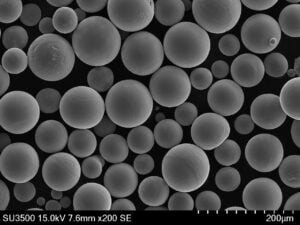Custom Exhaust Manifolds: Revolutionizing Performance with Metal 3D Printing
Table of Contents
The relentless pursuit of enhanced performance and efficiency drives innovation across industries, from the high-octane world of automotive racing to the stringent demands of aerospace engineering. A critical component in achieving these goals is the engine exhaust manifold. Traditionally manufactured through casting and welding, these intricate parts are now being reimagined through the transformative power of metal 3D printing. This advanced manufacturing technique offers unparalleled design freedom, material optimization, and performance enhancements that were previously unattainable. At Metal3DP, we are at the forefront of this revolution, providing cutting-edge metal additive manufacturing solutions that empower engineers and procurement managers to create custom exhaust manifolds tailored to their exact specifications. Our industry-leading print volume, accuracy, and reliability ensure the production of mission-critical parts that meet the most demanding requirements.
What are Custom Exhaust Manifolds Used For?
Custom exhaust manifolds play a pivotal role in a diverse range of applications, primarily focused on efficiently channeling exhaust gases away from the engine cylinders. Their design directly impacts engine performance, fuel efficiency, and emissions. Here’s a closer look at their key uses across different sectors:
- Automotive Industry:
- Performance Vehicles: In racing and high-performance cars, custom-designed manifolds optimize exhaust flow, reducing backpressure and increasing horsepower and torque. The ability to create complex geometries allows for tuned exhaust systems that maximize engine output.
- Aftermarket Upgrades: Enthusiasts often seek custom manifolds to improve the sound, aesthetics, and performance of their vehicles. Metal 3D printing enables the production of unique designs that cater to these specific needs.
- Prototyping and Low-Volume Production: For new vehicle development or niche models, additive manufacturing offers a cost-effective way to produce complex manifold designs without the need for expensive tooling.
- Aerospace Industry:
- Aircraft Engines: Efficient exhaust systems are crucial for aircraft performance and fuel economy. Metal 3D printing allows for the creation of lightweight yet robust manifolds with optimized flow paths, contributing to overall efficiency gains.
- Rocket Engines: In rocket propulsion systems, manifolds distribute and direct high-temperature exhaust gases. The ability to use high-performance materials and create intricate internal cooling channels via 3D printing is invaluable.
- Industrial Manufacturing:
- Power Generation: In industrial engines and turbines, custom exhaust manifolds can improve efficiency and reduce emissions. The durability offered by materials like IN625, available as high-quality metal powders from Metal3DP, ensures long-term reliability in demanding environments.
- Specialized Machinery: Various industrial applications require custom exhaust solutions tailored to specific engine configurations and space constraints. Metal 3D printing provides the flexibility to meet these unique requirements.
- Medical Equipment:
- While less common, certain specialized medical devices or research equipment might utilize small, custom-designed exhaust manifolds for ventilation or other gas management systems. The precision of metal 3D printing is crucial in such applications.
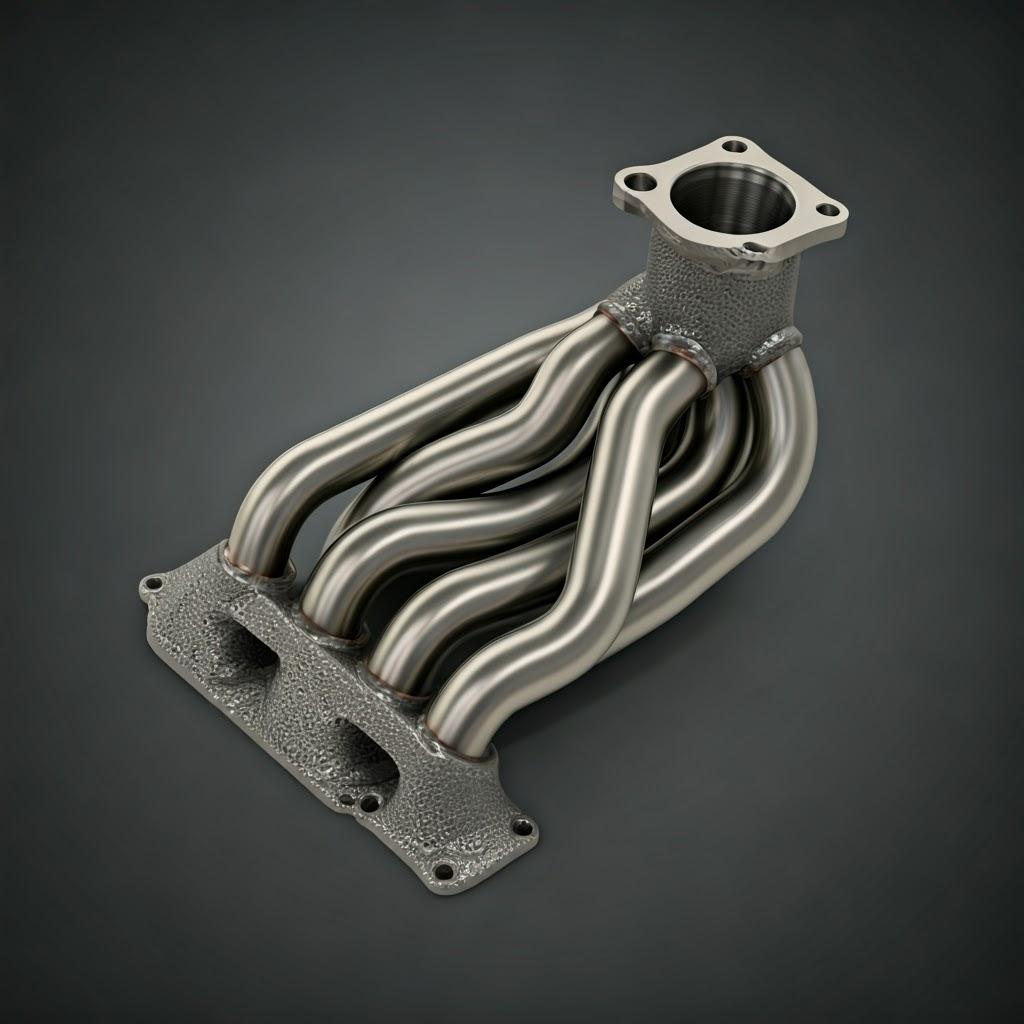
Why Use Metal 3D Printing for Custom Exhaust Manifolds?
Opting for metal 3D printing over traditional manufacturing methods like casting and welding offers a multitude of compelling advantages for producing custom exhaust manifolds:
- Design Freedom and Complexity: Additive manufacturing allows for the creation of intricate internal geometries, optimized flow paths, and complex shapes that are simply not possible or cost-effective with traditional techniques. This design freedom can lead to significant improvements in exhaust gas flow and engine performance.
- Material Optimization: Metal 3D printing enables the use of high-performance alloys like AlSi10Mg, Ti-6Al-4V, and IN625, offered by Metal3DP. These materials provide excellent strength-to-weight ratios, high-temperature resistance, and corrosion resistance, crucial for the demanding environment of exhaust systems. Our advanced Powder Making System ensures the production of high-quality metal powders with high sphericity and good flowability, essential for optimal printing results.
- Weight Reduction: By optimizing designs and utilizing materials with high strength-to-weight ratios, metal 3D printed exhaust manifolds can be significantly lighter than their traditionally manufactured counterparts. This is particularly beneficial in aerospace and automotive applications where weight reduction directly translates to improved fuel efficiency and performance.
- Rapid Prototyping and Iteration: Metal 3D printing significantly accelerates the prototyping process. Engineers can quickly design, print, and test different manifold iterations, allowing for faster design optimization and reduced time-to-market.
- Customization and Low-Volume Production: Unlike traditional methods that often require expensive tooling, metal 3D printing is ideal for producing highly customized manifolds or small production runs without significant upfront costs. This is particularly advantageous for niche markets, performance upgrades, or specialized applications.
- Integrated Features: Additive manufacturing allows for the integration of features like sensors, cooling channels, or mounting points directly into the manifold design, reducing the number of individual components and simplifying assembly.
- Reduced Waste: Metal 3D printing uses material only where needed, resulting in significantly less material waste compared to subtractive manufacturing processes. This can lead to cost savings and a more sustainable manufacturing approach.
- Improved Performance: Optimized flow paths and reduced backpressure achieved through 3D printed designs can lead to tangible improvements in engine horsepower, torque, and fuel efficiency.
Recommended Materials and Why They Matter
The choice of material is paramount in determining the performance and durability of a custom exhaust manifold. Metal3DP offers a range of high-quality metal powders specifically designed for additive manufacturing, including the following recommendations for exhaust manifold applications:
| Material | Key Properties | Benefits for Exhaust Manifolds | Why Metal3DP Material Stands Out | AlSi10Mg | Lightweight, good thermal conductivity, excellent mechanical properties, good corrosion resistance. | Reduces overall weight, dissipates heat effectively, provides the necessary strength for demanding conditions, offers good resistance to exhaust gases. | Our AlSi10Mg powder is produced with a narrow particle size distribution, ensuring excellent flowability and high density in the printed part, leading to superior mechanical properties and surface finish. You can learn more about our high-quality metal powders here: https://met3dp.com/product/ | | Ti-6Al-4V | High strength-to-weight ratio, excellent corrosion resistance, high-temperature performance, biocompatible. | Ideal for applications where weight is critical (e.g., aerospace, high-performance automotive), offers exceptional resistance to the corrosive environment of exhaust gases and maintains strength at elevated temperatures. | Metal3DP’s Ti-6Al-4V powder is manufactured using advanced gas atomization, resulting in spherical particles with high purity and low oxygen content, crucial for achieving optimal mechanical properties in the final component. | | IN625 | Exceptional high-temperature strength, excellent oxidation and corrosion resistance, good fatigue and creep resistance. | Best suited for extreme temperature environments, offering superior resistance to the harsh conditions within an exhaust system, ensuring long-term durability and reliability. | Our IN625 powder exhibits excellent flow characteristics, enabling the production of complex geometries with high density and dimensional accuracy, essential for demanding aerospace and industrial applications. To understand more about our printing methods, visit https://met3dp.com/printing-methods/ |
The selection of the appropriate powder depends heavily on the specific application requirements, including operating temperature, weight constraints, and corrosive environment. Consulting with the experts at Metal3DP can help you determine the optimal material for your custom exhaust manifold needs, leveraging our decades of collective expertise in metal additive manufacturing.
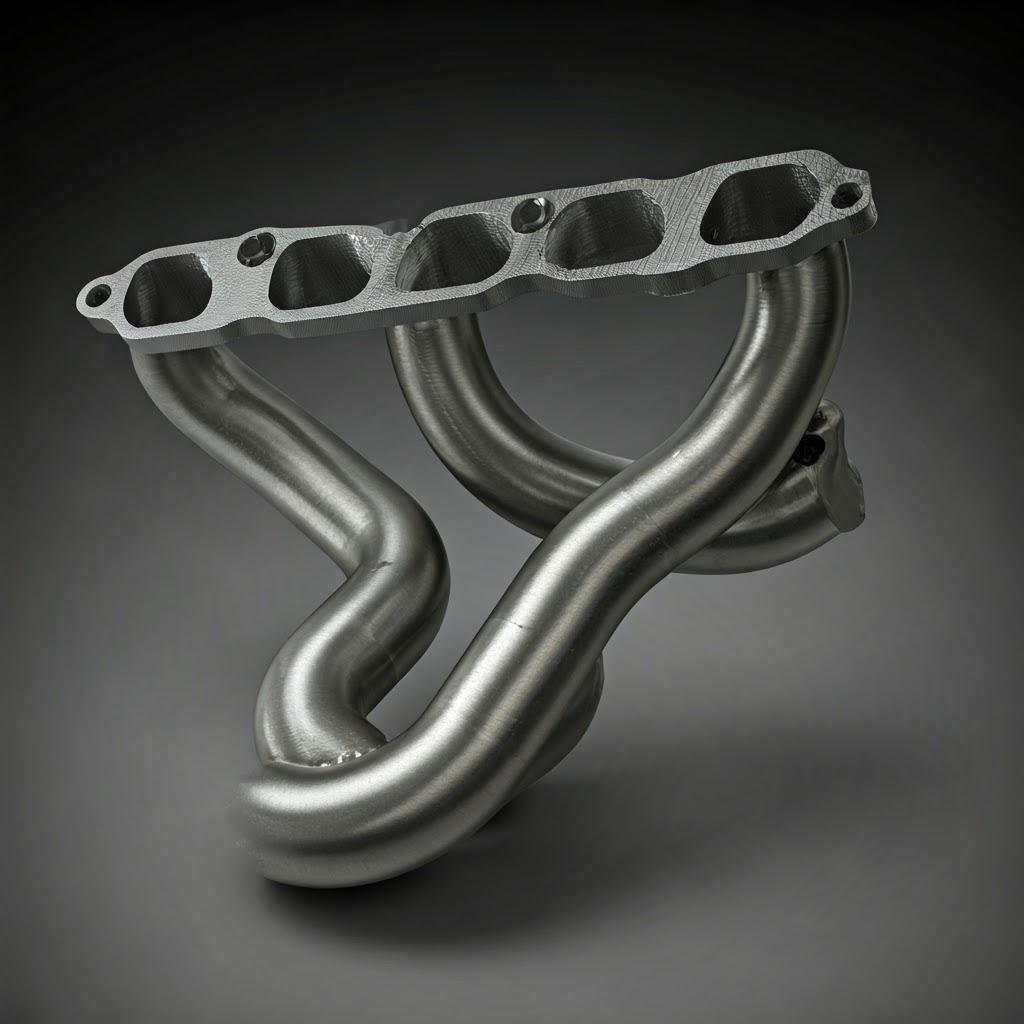
Design Considerations for Additive Manufacturing of Exhaust Manifolds
Designing for metal 3D printing requires a different mindset compared to traditional manufacturing. To fully leverage the capabilities of additive manufacturing for custom exhaust manifolds, several key design considerations must be taken into account:
- Topology Optimization: This computational approach can identify and remove material in non-critical areas while maintaining structural integrity. For exhaust manifolds, topology optimization can lead to significant weight reduction and improved material efficiency without compromising performance. The complex geometries resulting from this process are often only achievable through 3D printing.
- Lattice Structures: Incorporating lattice structures within the manifold design can further reduce weight and enhance thermal management. These intricate, interconnected networks of struts offer high strength-to-weight ratios and can be tailored to specific load-bearing requirements and heat dissipation needs.
- Wall Thickness and Ribbing: Optimizing wall thickness is crucial for balancing weight and structural integrity. Strategically placed ribs can reinforce thin-walled sections, providing the necessary stiffness without adding excessive mass. Metal 3D printing allows for the creation of complex ribbing patterns that can enhance both strength and thermal transfer.
- Support Structures: During the metal 3D printing process, support structures are often required to prevent warping, ensure proper overhang formation, and dissipate heat. Careful consideration of support structure design is essential for minimizing material usage, reducing post-processing effort, and achieving the desired surface finish. Our team at Metal3DP has extensive experience in optimizing part orientation and support generation for various geometries and materials.
- Internal Channels for Cooling or Sensors: One of the unique advantages of metal 3D printing is the ability to create complex internal channels. In exhaust manifold design, these channels can be utilized for internal cooling to manage high temperatures or for integrating sensors directly within the part to monitor performance in real-time.
- Part Consolidation: Additive manufacturing allows for the consolidation of multiple components into a single, 3D-printed part. For exhaust manifolds, this can mean integrating flanges, brackets, or sensor housings directly into the main structure, reducing the number of assembly steps and potential failure points.
- Surface Finish Considerations: The as-printed surface finish of a metal 3D printed part can vary depending on the material, printing process, and layer height. Design considerations should include the required surface finish for functionality and aesthetics, as this will impact post-processing requirements.
- Orientation within the Build Chamber: The orientation of the part during the printing process can significantly affect its mechanical properties, surface finish, and the amount of support material required. Careful consideration of build orientation is crucial for optimizing print quality and efficiency. Metal3DP leverages advanced simulation tools to determine the optimal build orientation for each part.
Tolerance, Surface Finish, and Dimensional Accuracy in Metal 3D Printed Exhaust Manifolds
Understanding the achievable tolerance, surface finish, and dimensional accuracy is critical for engineers designing custom exhaust manifolds using metal 3D printing. While these factors can vary depending on the specific printing technology, material, and post-processing techniques, Metal3DP is committed to delivering high levels of precision and quality.
- Dimensional Accuracy: Metal 3D printing technologies have advanced significantly, offering impressive dimensional accuracy. Typically, tolerances of ±0.1 to ±0.2 mm can be achieved for critical dimensions. However, larger parts may experience slightly greater deviations. Factors influencing dimensional accuracy include material shrinkage during solidification, thermal gradients during printing, and the calibration of the 3D printer. Metal3DP’s state-of-the-art SEBM printers are known for their high accuracy and reliability.
- Tolerance: Tolerance refers to the allowable variation in a specified dimension. With metal 3D printing, achieving tight tolerances often requires careful design, optimized build parameters, and potentially post-processing steps like CNC machining. Feature size and geometry also play a role in achievable tolerances. For critical mating surfaces or interfaces, it’s essential to design with appropriate tolerances in mind.
- Surface Finish: The as-printed surface finish in metal 3D printing typically has a certain degree of roughness due to the layered manufacturing process. The surface roughness (Ra) can range from 5 to 20 µm depending on the printing parameters and material. For applications requiring smoother surfaces, post-processing techniques such as polishing, sandblasting, or machining can be employed. The choice of powder, such as the high sphericity powders produced by Metal3DP, can also influence the as-printed surface finish.
| Feature | Typical Achievable Range with Metal 3D Printing | Factors Influencing | Improvement through Post-Processing |
|---|---|---|---|
| Dimensional Accuracy | ±0.1 to ±0.2 mm | Material, printer calibration, part size, build orientation | CNC machining can achieve tolerances down to ±0.01 mm or better. |
| Tolerance | Depends on feature size and geometry | Design, build parameters, material | Precision machining can significantly improve tolerances. |
| Surface Roughness (Ra) | 5 to 20 µm | Powder particle size, layer height, material, build orientation | Polishing can achieve Ra values below 1 µm; sandblasting can provide a more uniform matte finish. |
Export to Sheets
Understanding these limitations and capabilities early in the design process is crucial for achieving the desired functional and aesthetic requirements for custom exhaust manifolds. Consulting with Metal3DP’s experienced engineers can provide valuable insights into designing for optimal tolerance, surface finish, and dimensional accuracy.
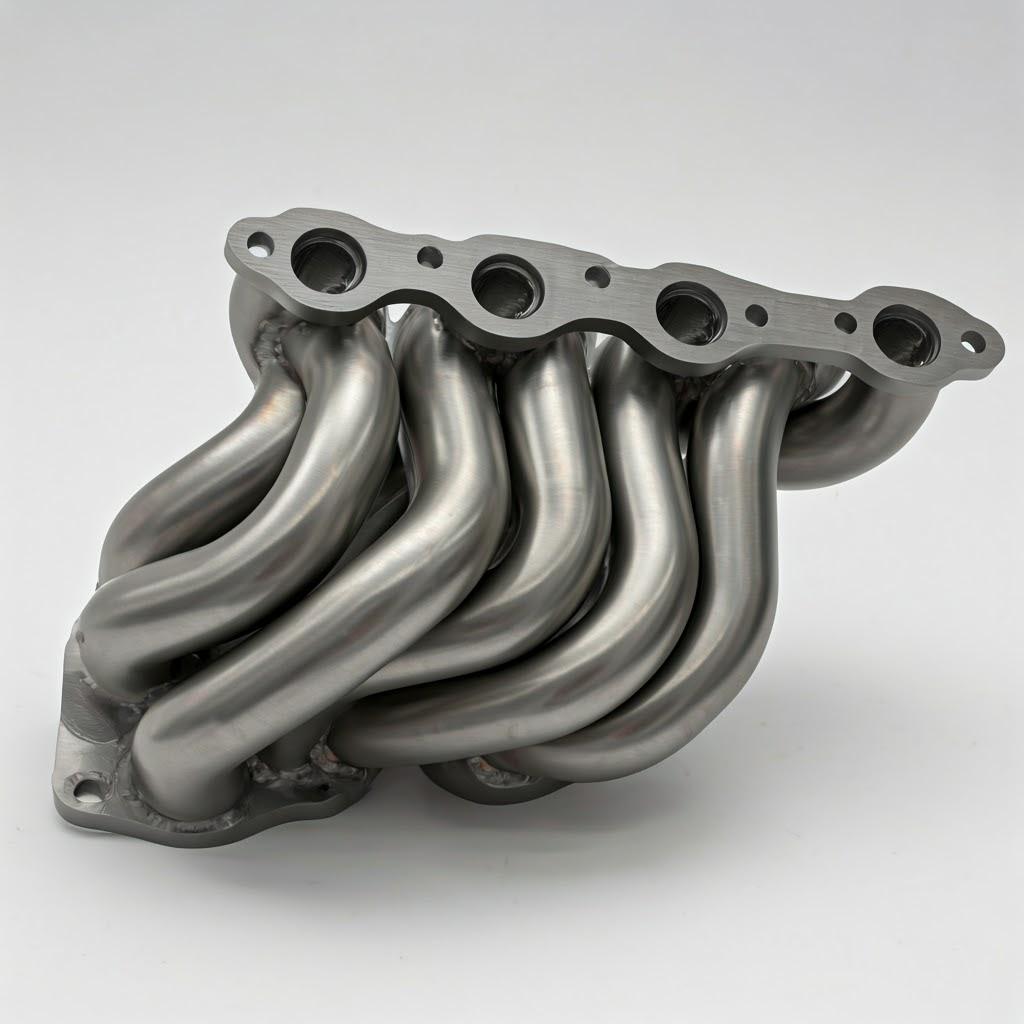
Post-Processing Requirements for Metal 3D Printed Exhaust Manifolds
While metal 3D printing offers significant advantages in creating complex geometries, post-processing is often necessary to achieve the final desired properties, surface finish, and dimensional accuracy of custom exhaust manifolds. Common post-processing steps include:
- Support Removal: After the printing process is complete, support structures that were used to support overhanging features and prevent warping need to be removed. This can be done manually using tools, or through automated processes like chemical dissolution, depending on the support material and part geometry. Careful design and optimized support generation, as practiced at Metal3DP, can minimize the effort required for support removal.
- Heat Treatment: To relieve internal stresses that may have built up during the rapid heating and cooling cycles of the 3D printing process, and to achieve the desired mechanical properties of the material, heat treatment is often required. This can involve processes like stress relieving, annealing, or hot isostatic pressing (HIP). The specific heat treatment cycle depends on the material and the intended application. Metal3DP has expertise in determining the optimal heat treatment protocols for the metal powders we offer.
- Surface Finishing: As mentioned earlier, the as-printed surface finish may not be suitable for all applications. Various surface finishing techniques can be employed to achieve smoother surfaces, improve aesthetics, or enhance corrosion resistance. These include:
- Media Blasting: Using abrasive media to remove loose powder and create a uniform surface texture.
- Polishing: Mechanically or chemically smoothing the surface to reduce roughness.
- Coatings: Applying protective layers such as ceramic coatings for thermal barrier properties or corrosion-resistant coatings.
- CNC Machining: For critical dimensions and tight tolerances that may not be achievable through 3D printing alone, CNC machining can be used as a secondary process. This is particularly relevant for mating surfaces, threaded holes, or other features requiring high precision.
- Inspection and Quality Control: Thorough inspection is crucial to ensure that the final part meets the required specifications. This can involve visual inspection, dimensional measurements using coordinate measuring machines (CMMs), and non-destructive testing methods like X-ray or ultrasonic inspection to detect internal defects. Metal3DP adheres to stringent quality control procedures to guarantee the integrity of our 3D printed parts.
The specific post-processing requirements for a custom exhaust manifold will depend on the application, material, and desired final properties. It’s essential to consider these requirements during the design phase to optimize the overall manufacturing process and cost. Metal3DP offers comprehensive solutions that include not only high-quality metal printing but also access to necessary post-processing services.
Common Challenges and How to Avoid Them in Metal 3D Printing of Exhaust Manifolds
While metal 3D printing offers numerous advantages, certain challenges can arise during the process. Understanding these potential issues and implementing appropriate strategies can help avoid them when manufacturing custom exhaust manifolds:
- Warping and Distortion: Thermal stresses during the printing process can lead to warping or distortion of the part, especially for complex geometries or thin-walled structures.
- How to Avoid: Optimize part orientation in the build chamber, use appropriate support structures to anchor the part, and carefully control the printing parameters and build plate temperature. Simulation software can also help predict and mitigate potential warping.
- Porosity: Internal voids or pores within the printed part can compromise its mechanical strength and fatigue resistance.
- How to Avoid: Utilize high-quality metal powders with good flowability and packing density (like those offered by Metal3DP), optimize printing parameters such as laser power and scan speed, and ensure a controlled printing environment. Hot isostatic pressing (HIP) can also be used as a post-processing step to reduce porosity.
- Support Removal Difficulties: Intricately designed support structures can be challenging to remove without damaging the part’s surface.
- How to Avoid: Design self-supporting geometries whenever possible, optimize support structure design for easy removal, and consider using dissolvable support materials if compatible with the chosen metal powder.
- Surface Roughness: Achieving a smooth surface finish directly from the printing process can be difficult.
- How to Avoid: Optimize printing parameters such as layer height and scan strategies. Plan for necessary post-processing steps like media blasting or polishing early in the design phase. Using powders with high sphericity, like those produced using Metal3DP’s advanced Powder Making System, can also improve the as-printed surface finish.
- Material Property Variations: Inconsistent material properties throughout the printed part can occur due to variations in the printing process.
- How to Avoid: Ensure the 3D printer is properly calibrated and maintained, use consistent and high-quality metal powders, and optimize the build parameters for the chosen material. Heat treatment can also help homogenize the material properties.
- Residual Stresses: Rapid heating and cooling during printing can lead to residual stresses within the part, potentially causing cracking or failure under load.
- How to Avoid: Employ appropriate heat treatment cycles after printing to relieve residual stresses. Optimize the printing strategy to minimize thermal gradients.
- Cost Considerations: While metal 3D printing can be cost-effective for low-volume production and complex geometries, the cost per part can be higher than traditional methods for large production runs or simpler designs.
- How to Avoid: Carefully evaluate the production volume and complexity of the part to determine if metal 3D printing is the most cost-effective solution. Optimize designs to minimize material usage and printing time. Partnering with an experienced service provider like Metal3DP can ensure cost-efficient production through optimized processes and material selection.
By understanding these potential challenges and implementing appropriate design and process control strategies, engineers and procurement managers can effectively leverage metal 3D printing to create high-performance custom exhaust manifolds.
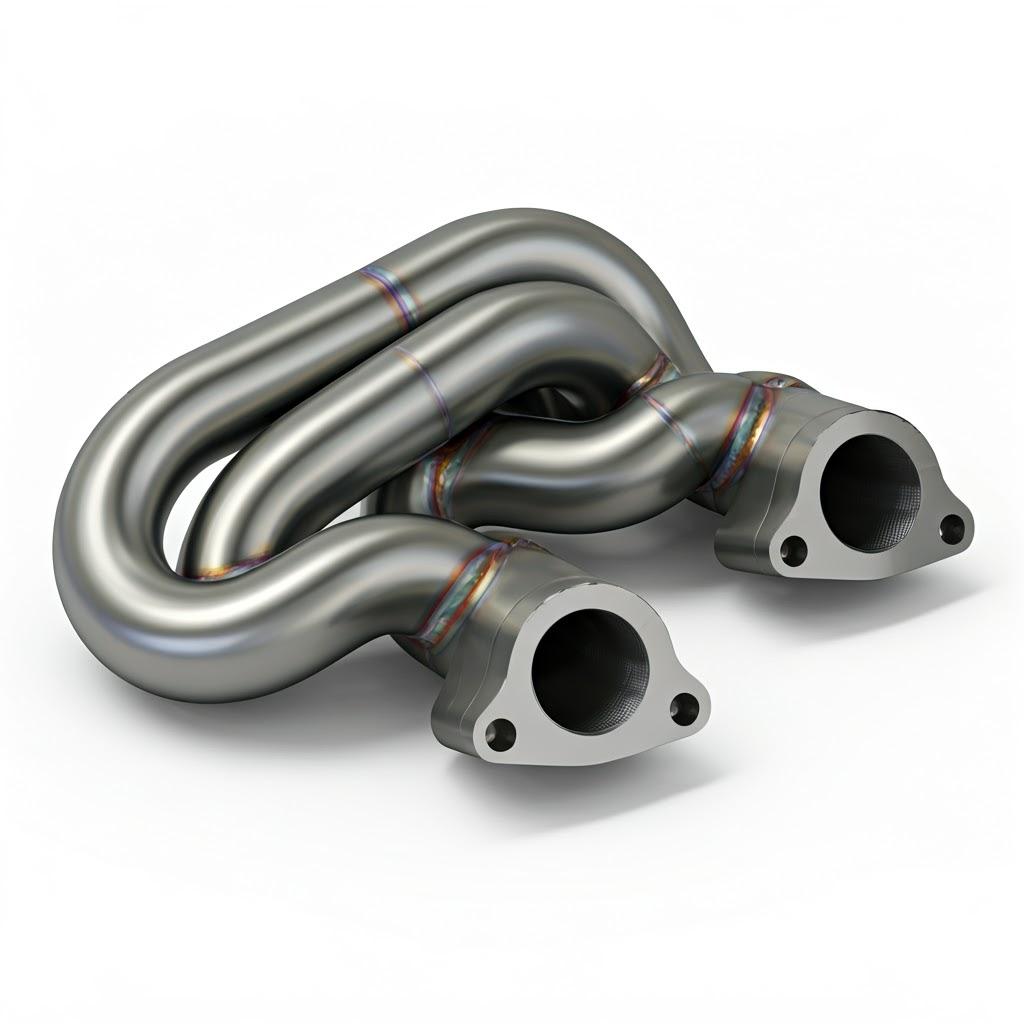
How to Choose the Right Metal 3D Printing Service Provider for Custom Exhaust Manifolds
Selecting the right metal 3D printing service provider is crucial for ensuring the successful fabrication of high-quality custom exhaust manifolds that meet your specific requirements. Here are key factors to consider when evaluating potential suppliers:
- Material Capabilities: Ensure the service provider offers the specific metal powders required for your application, such as AlSi10Mg, Ti-6Al-4V, or IN625. Verify the quality and traceability of their materials. Metal3DP prides itself on its wide range of high-quality metal powders, manufactured using industry-leading gas atomization and PREP technologies.
- Printing Technology and Equipment: Understand the types of metal 3D printing technologies the provider utilizes (e.g., SLM, DMLS, EBM). Different technologies offer varying levels of precision, surface finish, and build volume. Metal3DP employs advanced SEBM printers known for their industry-leading print volume, accuracy, and reliability. You can explore our metal 3D printing services further at https://met3dp.com/metal-3d-printing/.
- Design and Engineering Support: A strong service provider should offer design consultation and engineering support to optimize your manifold design for additive manufacturing. This includes guidance on topology optimization, support structure design, and material selection. Metal3DP’s team possesses decades of collective expertise in metal additive manufacturing and provides comprehensive application development services.
- Post-Processing Services: Inquire about the in-house or partnered post-processing capabilities, such as heat treatment, surface finishing (polishing, coating), and CNC machining. Ensure they can meet the required specifications for your application.
- Quality Assurance and Certifications: Verify if the provider has robust quality management systems and relevant certifications (e.g., ISO 9001, AS9100 for aerospace). This demonstrates their commitment to quality and process control.
- Experience and Expertise: Look for a provider with a proven track record in metal 3D printing, ideally with experience in producing parts for similar applications or industries (e.g., automotive, aerospace).
- Build Volume and Capacity: Ensure the provider has sufficient build volume and production capacity to handle the size and quantity of manifolds you require, especially for larger production runs. Metal3DP’s printers deliver industry-leading print volumes.
- Lead Times: Understand the typical lead times for design, printing, and post-processing. This is crucial for project planning and meeting deadlines.
- Cost Structure: Obtain a clear breakdown of the costs involved, including material, printing, post-processing, and any design or engineering fees. Compare quotes from multiple providers to ensure competitive pricing.
- Communication and Customer Support: Evaluate the responsiveness and clarity of communication from the service provider. A collaborative partner who understands your needs is essential for a successful project. Consider reaching out to Metal3DP to discuss your specific requirements.
- Confidentiality and Intellectual Property Protection: Ensure the provider has strong policies and agreements in place to protect your intellectual property and maintain confidentiality.
By carefully evaluating these factors, you can select 1 a metal 3D printing service provider like Metal3DP that can deliver high-quality custom exhaust manifolds tailored to your exact specifications, on time and within budget.
Cost Factors and Lead Time for Metal 3D Printed Exhaust Manifolds
Understanding the factors that influence the cost and lead time for metal 3D printed custom exhaust manifolds is essential for effective project planning and budgeting:
Cost Factors:
- Material Cost: The type and quantity of metal powder used are significant cost drivers. High-performance alloys like Ti-6Al-4V and IN625 are generally more expensive than materials like AlSi10Mg. The complexity of the design and the amount of support material required will also impact material consumption. Metal3DP offers a range of high-quality metal powders at competitive prices.
- Printing Time: The duration of the printing process directly affects the cost. Factors influencing print time include the part’s size and complexity, the layer height used, and the printing technology. Larger or more intricate manifolds will typically take longer to print.
- Post-Processing Costs: The extent of post-processing required (support removal, heat treatment, surface finishing, machining, inspection) will add to the overall cost. Complex geometries or stringent surface finish requirements will necessitate more extensive and potentially more expensive post-processing steps.
- Design and Engineering Fees: If you require design optimization or engineering support from the service provider, these services will incur additional costs. However, this upfront investment can often lead to more efficient printing and better part performance in the long run. Metal3DP offers comprehensive application development services to assist with design and optimization.
- Machine and Operational Costs: Service providers factor in the cost of operating and maintaining their 3D printing equipment, as well as labor costs, into their pricing.
- Quantity: While metal 3D printing is advantageous for low to medium volume production, the cost per part may decrease with larger quantities due to economies of scale in material procurement and potentially optimized printing setups.
Lead Time Factors:
- Design and Engineering Phase: The time required for design optimization, simulation, and preparation of the build files will impact the overall lead time.
- Printing Time: As mentioned above, the printing duration is a key component of the lead time.
- Post-Processing Time: Each post-processing step (support removal, heat treatment, surface finishing, inspection) adds to the total lead time. The complexity and number of post-processing steps will directly influence this duration.
- Scheduling and Capacity: The service provider’s current workload and machine availability will affect how quickly your parts can be scheduled for printing.
- Shipping Time: The time required for shipping the finished parts to your location must also be considered. Metal3DP is headquartered in Qingdao, China, and can provide estimated shipping times based on your location.
By carefully considering these cost and lead time factors and discussing them with potential service providers like Metal3DP, you can gain a clear understanding of the overall investment and timeline for your custom exhaust manifold project.
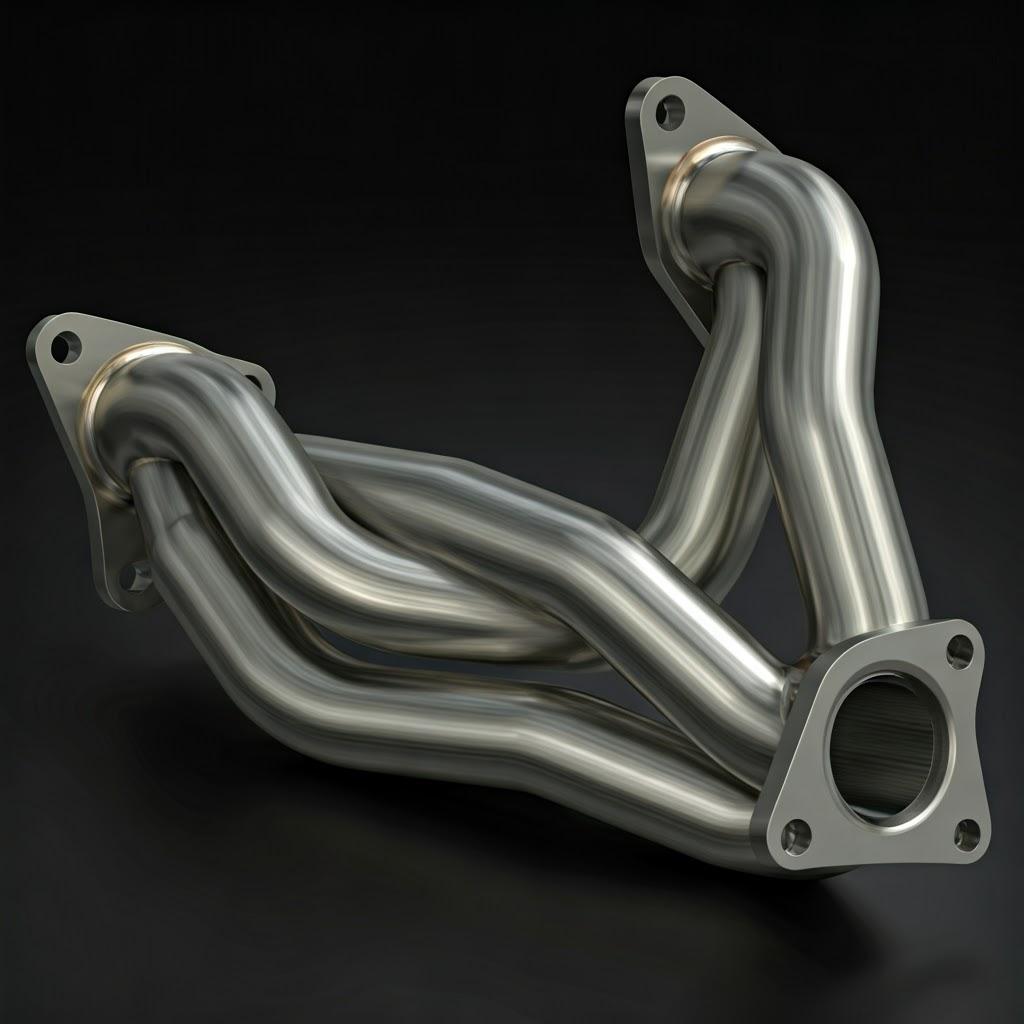
Frequently Asked Questions (FAQ)
- What are the typical applications for metal 3D printed exhaust manifolds? Metal 3D printed exhaust manifolds are commonly used in high-performance automotive, aerospace, industrial machinery, and specialized engine applications where design freedom, weight reduction, and performance optimization are critical.
- Can metal 3D printed exhaust manifolds withstand high temperatures? Yes, with the appropriate material selection (e.g., Ti-6Al-4V, IN625 offered by Metal3DP) and proper heat treatment, metal 3D printed exhaust manifolds can withstand the high temperatures encountered in exhaust systems.
- What kind of surface finish can be achieved on metal 3D printed exhaust manifolds? The as-printed surface finish typically has a certain roughness. However, various post-processing techniques such as polishing, media blasting, and coatings can be applied to achieve smoother surfaces or specific aesthetic and functional requirements.
Conclusion
Metal 3D printing has emerged as a transformative technology for the design and manufacturing of custom exhaust manifolds. Its ability to enable complex geometries, optimize material usage, reduce weight, and enhance performance offers significant advantages over traditional manufacturing methods for industries ranging from automotive to aerospace. By partnering with a leading provider like Metal3DP, with our advanced printing technology, high-quality metal powders, and comprehensive expertise, engineers and procurement managers can unlock new possibilities in exhaust system design and achieve unparalleled levels of performance and efficiency. Contact Metal3DP today to explore how our capabilities can power your organization’s additive manufacturing goals.
Share On
MET3DP Technology Co., LTD is a leading provider of additive manufacturing solutions headquartered in Qingdao, China. Our company specializes in 3D printing equipment and high-performance metal powders for industrial applications.
Inquiry to get best price and customized Solution for your business!
Related Articles
About Met3DP
Recent Update
Our Product
CONTACT US
Any questions? Send us message now! We’ll serve your request with a whole team after receiving your message.

Metal Powders for 3D Printing and Additive Manufacturing
COMPANY
PRODUCT
cONTACT INFO
- Qingdao City, Shandong, China
- [email protected]
- [email protected]
- +86 19116340731









